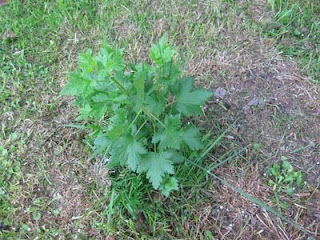The peas did pretty well. We ate them all straight from the pod, and there are even a few more coming on now - for some reason, the early pods were small, with peas packed in tightly, and the later pods have been huge, with peas of the same size as the small ones, but more widely separated. The beans are less impressive; of four or five plants, I see two actual beans so far, and little sign of more - but perhaps they're a later crop. I've a later planting of some other broad beans coming in behind them, anyway - only seedlings as yet.
Also only at the seedling stage are the lettuces - this is because the damnable slugs (I think) have eaten every other lettuce of the four other attempts this year. These ones are being grown in containers on a shelf two-thirds of the way up the east-by-south-east facing wall of the shed; slugs that can reach them there will be impressive. I say slugs; I've not actually seen any, but I can't think of much else that will so thoroughly destroy seedlings.
The strawberries are suffering more from the lack of sun than anything else, really. There are lots of immature fruit - and I spent this morning making sure the strawberry bed is as thoroughly bird-proofed as it can be, and has netting strung high over it - but they're just not ripening. I reckon there'll be a better crop from them next year, assuming that there's more sun.
The onions seem to be doing relatively well. The stalks are falling, they're swelling nicely, and I'm happy to let them sit for a couple more weeks. Oddly, the ones in the middle of the patch seem to have done better than the ones on the edge, which is not what I would have guessed.
The pumpkins are fine healthy plants. There is, however, no sign of a vine as such, and no sign of flowers, let alone fruits setting. I'm blaming lack of sunlight again, although I suppose they might find the soil a bit uninspiring. I shall try adding more compost around some of them, keep the rest as a control, and see if that makes any difference. My aim for them is one decent sized pumpkin by Hallowe'en, so it shouldn't take too much for that. Right?
The Siberian tomatoes are on one fruit apiece, swelling slowly. The first tomato of the year fell off before it completely ripened, and had seen extensive use as a cat toy before I got to it. It's possible the Small Cat picked it himself, although not all that likely.
Last year's pepper has eight fruits - mostly small and black, but apparently turning green as they get bigger. I do not understand that plant at all; it's supposed to be a greenhouse annual, but it's producing better outdoors in its second year.
I think there's an asparagus frond out there. I'm not sure; I've never seen one before, but it's a delicate looking fern-ish thing, looking a bit like dill. Of three crowns, one frond is a little poor, but we'll see what happens next spring.
One blueberry bush took a sniff at our soil and died, the one right next to it seems to be fine, and has a couple of bunches of immature fruit. Some sunshine, much as with the rest of the garden, will probably ripen them nicely.
The fruit trees are there, leaves but no fruit, all but one pear, which looks dead. On the other hand, they flowered in frosts in late November last year, so I reckon a year for them to work out seasons is reasonable. A friend reckons her pear tree will over-produce this year, so I'll be seeing what can be done to preserve some of those. The soft fruit bushes - one gooseberry and some currants - seem to be in the same state. If they go about producing next year, I'll need more nets, though.
And in the herb end of things... the thyme which is alive, but really not doing much. I reckon the soil it's in may be too rich, although that would typically make it grow long stalks. I'll see how it's doing around September, and maybe move it elsewhere. Mint, two kinds, both confined to pots, are doing ok. They're not taking over every inch of space in their pots yet, and if they behave, they may get planted into clear ground. I know mint spreads, but I can live with that, and prefer it to lots of other possibilities. Oregano, alongside one of the mints, seemed to have rather arbitrarily dried out when I was looking at it today; I've given it a good watering, and will see what happens. And the basil - again, an indoor variety - is doing fine, if a little paler than I'd really like. There's a bay tree, which is thriving, and some lavender, which is doing well.
Finally, the potatoes grew up, grew flowers, some of them grew fruit, and fell over, all as it should be, except that as far I could see from the one row we pulled, they have about three potatoes per plant, plus a few really tiny ones. They're Roosters, so they should have some more than that. They were on the outside edge of the bed, though, so I reckon I'll leave the rest for a couple more weeks, and then see how we do.
The garden looks much more populated when I write it down than it does when I look out the window, I have to say...





















